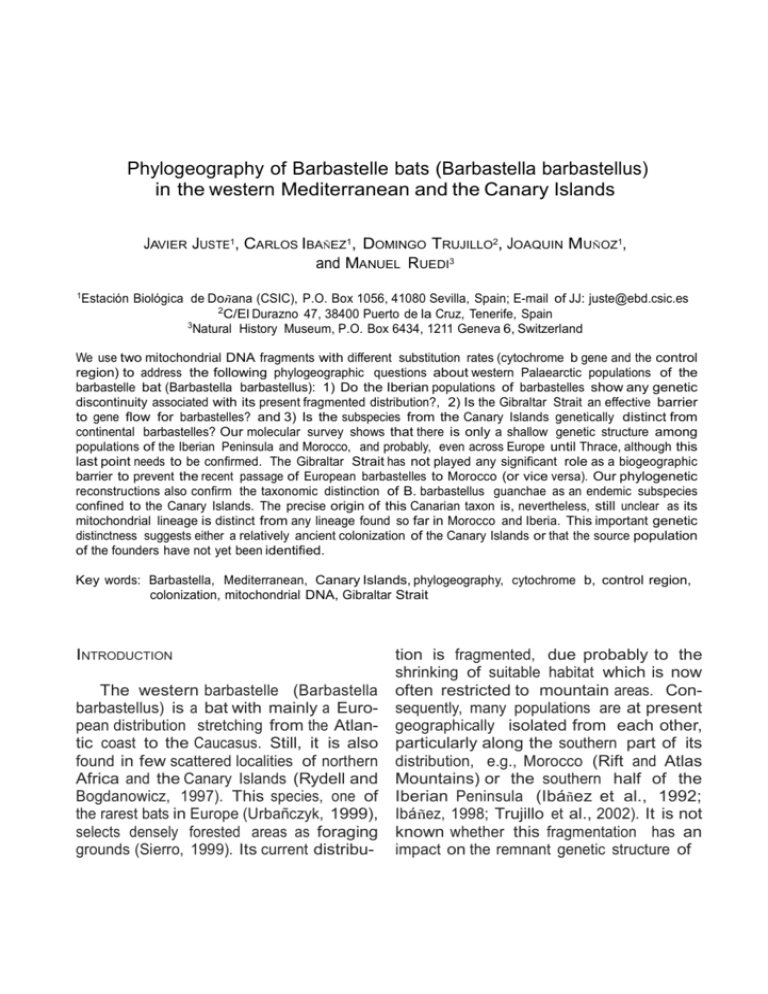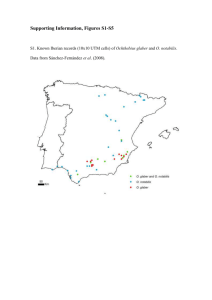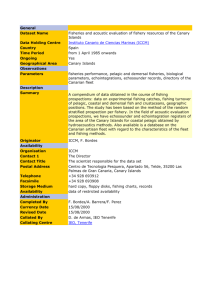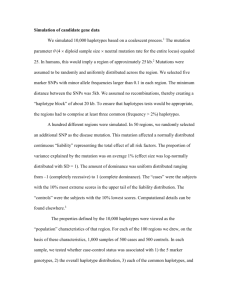2003 barbastella phyl... - digital
advertisement

Phylogeography of Barbastelle bats (Barbastella barbastellus) in the western Mediterranean and the Canary Islands JAVIER JUSTE1, CARLOS IBAÑEZ1, DOMINGO TRUJILLO2, JOAQUIN MUÑOZ1, and MANUEL RUEDI3 1Estación Biológica de Doñana (CSIC), P.O. Box 1056, 41080 Sevilla, Spain; E-mail of JJ: juste@ebd.csic.es 2C/El Durazno 47, 38400 Puerto de la Cruz, Tenerife, Spain 3Natural History Museum, P.O. Box 6434, 1211 Geneva 6, Switzerland We use two mitochondrial DNA fragments with different substitution rates (cytochrome b gene and the control region) to address the following phylogeographic questions about western Palaearctic populations of the barbastelle bat (Barbastella barbastellus): 1) Do the Iberian populations of barbastelles show any genetic discontinuity associated with its present fragmented distribution?, 2) Is the Gibraltar Strait an effective barrier to gene flow for barbastelles? and 3) Is the subspecies from the Canary Islands genetically distinct from continental barbastelles? Our molecular survey shows that there is only a shallow genetic structure among populations of the Iberian Peninsula and Morocco, and probably, even across Europe until Thrace, although this last point needs to be confirmed. The Gibraltar Strait has not played any significant role as a biogeographic barrier to prevent the recent passage of European barbastelles to Morocco (or vice versa). Our phylogenetic reconstructions also confirm the taxonomic distinction of B. barbastellus guanchae as an endemic subspecies confined to the Canary Islands. The precise origin of this Canarian taxon is, nevertheless, still unclear as its mitochondrial lineage is distinct from any lineage found so far in Morocco and Iberia. This important genetic distinctness suggests either a relatively ancient colonization of the Canary Islands or that the source population of the founders have not yet been identified. Key words: Barbastella, Mediterranean, Canary Islands, phylogeography, cytochrome b, control region, colonization, mitochondrial DNA, Gibraltar Strait INTRODUCTION tion is fragmented, due probably to the shrinking of suitable habitat which is now The western barbastelle (Barbastella often restricted to mountain areas. Conbarbastellus) is a bat with mainly a Euro- sequently, many populations are at present pean distribution stretching from the Atlan- geographically isolated from each other, tic coast to the Caucasus. Still, it is also particularly along the southern part of its found in few scattered localities of northern distribution, e.g., Morocco (Rift and Atlas Africa and the Canary Islands (Rydell and Mountains) or the southern half of the Bogdanowicz, 1997). This species, one of Iberian Peninsula (Ibáñez et al., 1992; the rarest bats in Europe (Urbañczyk, 1999), Ibáñez, 1998; Trujillo et al., 2002). It is not selects densely forested areas as foraging known whether this fragmentation has an grounds (Sierro, 1999). Its current distribu- impact on the remnant genetic structure of barbastelle bats, or whether major historical barriers such as the Gibraltar Strait have played any role in shaping this genetic structure by impeding genetic exchanges between Iberian and Maghrebian populations. The Canary Islands are part of the Macaronesian region and support only six distinct genera of bats: Barbastella, Plecotus, Pipistrellus, Hypsugo, Nyctalus and Tadarida (Trujillo, 1991; Mitchell-Jones et al., 1999). In the Canarian archipelago, western barbastelle bats are quite rare as they are known, so far, only from La Gomera and Tenerife islands (Trujillo, 1991). Moreover, these island populations are also morphologically distinct from continental counterparts, and in fact, have recently been proposed to represent a distinct endemic subspecies (Trujillo et al., 2002). If valid, this new taxon would be the only subspecies of B. barbastellus, which is otherwise considered as monotypic throughout its distribution (Rydell and Bogdanowicz, 1997; Horá ek et al., 2000). Estimating the degree of intra-specific genetic structure and understanding the forces that determine genetic patterns in a particular species, are of high interest both from evolutionary and conservation perspectives. In relation to the barbastelle bats and using a phylogeographic approach based on mitochondrial DNA (mtDNA), we were interested in focusing on three main questions: (1) Do the Iberian populations of barbastelles show any genetic discontinuity associated with its present fragmented distribution?, (2) Is the Gibraltar Strait an effective barrier to gene flow for barbastelles? and (3) Is the subspecies from the Canary Islands genetically distinct from continental barbastelles?. MATERIALS AND METHODS Samples and DNA amplification A total of 24 B. barbastellus were sampled from the Iberian Peninsula, Central Europe, Thrace, Morocco and the Canary Islands (Fig. 1, Table 1). FIG. 1. Map of the approximate distribution of Barbastella barbastellus in the western Palaearctic according to Urbañczyk (1999) and localities sampled for this study (see Table 1 for details) TABLE 1. List of specimens, localities and accession numbers of the samples of B. barbastellus used for this study. cyt-b — cytochrome b, CR control region Specimen Geographic coordinates La Gomera, Canary Is., Spain La Gomera, Canary Is., Spain La Gomera, Canary Is., Spain Santa Ursula, Tenerife, Canary Is., Spain Santa Ursula, Tenerife, Canary Is., Spain La Matanza, Tenerife, Canary Is., Spain Azrou, Morocco Tetouan, Morocco Viator, AlmerIa, Spain RIo Bornova, Guadalajara, Spain El Rasillo, La Rioja, Spain El Rasillo, La Rioja, Spain El Rasillo, La Rioja, Spain El Rasillo, La Rioja, Spain Belsué, Huesca, Spain Belsué, Huesca, Spain Belsué, Huesca, Spain Ordesa, Huesca, Spain Ordesa, Huesca, Spain Ortigueira, A Coruna, Spain Baza, Granada, Spain Sarpdere, Thrace, Turkey Sarpdere, Thrace, Turkey Martigny, Valais, Switzerland 28°06’N, 17°08’W 28°06’N, 17°08’W 28°06’N, 17°08’W 28°24’N, 16°28’W 28°24’N, 16°28’W 28°25’N, 16°26’W 33°24’N, 05°13’W 35°35’N, 05°20’W 36°53’N, 02°25’W 41°10’N, 03°00’W 42°12’N, 02°41’W 42°12’N, 02°41’W 42°12’N, 02°41’W 42°12’N, 02°41’W 42°19’N, 00°22’W 42°19’N, 00°22’W 42°19’N, 00°22’W 42°40’N, 00°00’W 42°40’N, 00°00’W 43°41’N, 07°51’W 37°23’N, 02°51’W 40°52’N, 26°25’E 40°52’N, 26°25’E 46°10’N, 07°08’E GenBank Acc.N° cyt-b CR AF513745 AF513745 AF513745 AF513745 AF513745 AF513752 AY254570 AF513750 AF513748 AF513746 AF513747 AF513748 AF513748 AF513750 AF513749 AF513749 AF513749 AF513749 AF513750 AF513753 AF513751 AF513749 AF515152 AF515152 AF515152 AF515152 AF515152 AF515152 AF515162 AY254218 AF515158 AF515154 AF515153 AF515154 AF515155 AF515154 AF515163 AF515156 AF515156 AF515161 AF515156 AF515164 AF515158 AF515159 AF515160 AF515157 Voucher EBD16028 EBD16024 MNH110 Biopsy Biopsy Biopsy EBD25831 Biopsy Biopsy Biopsy EBD15181 EBD15981 Biopsy Biopsy Biopsy Biopsy Biopsy Biopsy Biopsy Biopsy Biopsy Biopsy Biopsy MHNG 1804.94 Phylogeography of western Palaearctic barbastelles Bba9.CAG Bba10.CAG Bba150.CAG Bba148.CAT Bba149.CAT Bba49.CAT Bba35.MO Bba850.MO Bba174.IB Bba197.IB Bba11.IB Bba12.IB Bba145.IB Bba146.IB Bba47.IB Bba48.IB Bba147.IB Bba277.IB Bba278.IB Bba89.IB Bba849.IB Bba198.TK Bba199.TK Bba165.SW Locality 167 DNA was extracted either from wing biopsies following Higuchi et al. (1988) or from tissue samples preserved in ethanol following standard phenol/chloroform protocols (Maniatis et al., 1989). The primer pair L14724 (Irwin et al., 1991) and MVZ16 (Smith and Patton, 1993) was used to amplify a fragment about 800 bp long of the mitochondrial cytochrome b gene (cyt-b). Likewise, primers L15975 (Wilkinson and Chapman, 1991) and H16498 (Fumagalli et al., 1996) were used to amplify the left domain of the mitochondrial control region (CR). This non-coding segment includes the first hyper-variable region (HV1) and usually a stretch of variable tandem R1 repeats (Fumagalli et al., 1996; Wilkinson et al., 1997). The PCR profile consisted in 4 min initial denaturation at 94°C followed by 39 cycles of 60 s at 94°C, 30 s at 45 50°C (for the cyt-b), and 2 min at 72°C and a final extension of 10 min at 72°C. The annealing temperature for the CR was 55°C. PCR products were purified and sequenced using an ABI 377 or an ABI 3100 automated sequencer (PE Biosystems, Warrington, UK) following the manufacturer’s protocols. Sequence and Phylogenetic Analyses Alignments were obtained with Sequencher 4.1 (Gene Codes Crop.). No evidence of heteroplasmy was detected in any individual. For the non-coding region, the sequences were further inspected by eye to minimize alignment gaps (indels). Only different haplotypes for each fragment were included in the analyses. For each data set, the best fitting substitution model was selected with hierarchical likelihood ratio tests (LRT) (Modeltest soft., Posada and Crandall, 1998) and levels of genetic differentiation between groups were calculated using MEGA v. 2.1 (Kumar et al., 2001). After testing for congruence between data sets, the 5’ end of the CR fragment was joined to the 3’ end of the cyt-b sequence in a single string to obtain the most informative phylogenetic reconstruction. A Maximum Parsimony (MP) approach (unweighed heuristic search, TBR branch swapping) was used to build our phylogenetic hypothesis using PAUP* 4.0b10 (Swofford, 2000). Robustness of the topology was assessed through bootstrapping (Felsenstein, 1985) with 5000 replicates and heuristic search. Another approach to infer phylogenetic relationships consisted in the construction of a median-joining network (Bandelt et al., 1999) with all haplotypes found in the joint sequences. This approach combines the topology of a minimum spanning tree with a parsimony-based search of the absent nodes or haplotypes (median vectors) not found in the sampling (Posada and Crandall, 2001). The network was obtained with the software NETWORK 3.1.1 (Röhl, 2003). RESULTS A 680 bp fragment of the cyt-b and 391 bp of CR were sequenced and aligned for 22 and 24 specimens respectively (Table 1). For the cyt-b, a total of 10 different haplotypes were found that showed 45 variable positions (Table 2) of which 19 were parsimony informative. Most of substitutions were transitions and located in third positions (77.8%). For the CR fragment, we found more variability, although less than the expected five times higher variation with respect to the cyt-b fragment. In fact, the 24 CR sequences represented a total of 13 different haplotypes with 75 polymorphic sites (Table 2) of which 32 where parsimony informative. The alignment of this fragment required two deletions in the unique haplotype from the Canary Islands (Table 2). All unique haplotypes in both CR and cyt-b fragments are deposited in GenBank (accession numbers in Table 1). The overall nucleotide composition was biased towards a deficit of guanine for cyt-b sequences (A = 0.283, C = 0.293, G = 0.159, T = 0.264), a result typical for mammalian sequences. On the other hand, the fragment of CR showed cytosine bias (A = 0.248, C = 0.113, G = 0.258, T = 0.380). For the cyt-b, the selected model was HKY85 with a Ts:Tv ratio of 5.55, no invariable sites and site heterogeneity (γ-shape parameter = 0.008). Similarly, for the CR a HKY85 model was selected with a Ts:Tv ratio of 15.04 with site heterogeneity (γshape parameter = 0.14). Both partitions of sequences showed high compatibility (P = 0.91 in a partitionhomogeneity test). The MP reconstruction based on the 14 different haplotypes for the concatenated sequenced resulted in three trees with length of 156 steps and consistency index of 0.823 and retention index of TABLE 2. Polymorphic sites identified in the mitochondrial DNA fragments sequenced of B. barbastellus for the cyt-b (n = 45) (above), and for the CR (bellow) Number of Variable Sites Hap 111111111122222222223333333333444444 123456789012345678901234567890123456789012345 CCTTTGAAGTTCCTTGCGCACGGCATGTAGAAGAAAATCGTGTTA C A G G C T A C T C T A G C T G TC A A T C TA G C T A A T C T G C T A C T C T A G C T G AATCTCCC T A TC GA A G GAATCTCCC T GCAGGA CTTCCCTA AATGC CTA AGTGG C Number of Variable Sites Hap # Bba11IB Bba12IB Bba47IB Bba48IB Bba145IB Bba174IB Bba277IB Bba35MO Bba850MO Bba165SW Bba198TK Bba199TK Bba9CAG 11111111112222222222333333333344444444445555555555666666666677777777 12345678901234567890123456789012345678901234567890123456789012345678901234567 GGTGTACGGCATAGTACCTCGTTAATTCCGGTAAATTGCGAGGGTACTATACGTAATTTAGTAGGAAAGTACGCACC T A G A C C A G A C TT C G A T C GA T A G A C A G A C G C TT C G AG C C G GA A TAA T A G G TA A AC T G G G TA A TA T A G G TA A AC T G C G TA A C TT C G A C C GA C A T C A G A C TA A GA G A A G A T CC T A G A C TA GA G G A G AA -GTAC TGCGACGTTCTACCGGC T AA G-GGTG G AACGTC G A G CGAC AG G G T TGGT Phylogeography of western Palaearctic barbastelles Bba11IB Bba12IB Bba48IB Bba174IB Bba35MO Bba850MO Bba165SW Bba198TK Bba199TK Bba9CAG # 169 0.759. The consensus tree (Fig. 2) is well structured and indicates a sharp distinction between the lineage from the Canary Islands and all haplotypes of barbastelle bats from the rest of the range (Iberia, Switzerland, Morocco and Turkey). This tree further differentiates Moroccan and Turkish haplotypes in two well-supported groups. Finally, it also supports three clades among the Iberian samples: one (IB-1) that is widespread across the Peninsula, one (IB-2) restricted to the northern parts, and FIG. 2. Maximum Parsimony reconstruction (unweighed heuristic search, TBR branch swapping) of the phylogenetic relationships of western Palaearctic Barbastella bats based on the sequences of 14 different haplotypes (in 22 specimens) in a joint fragment of the cytochrome b gen (680 bp) and the control region (391 bp). Bootstrap values after 5000 replicates. Location codes: CAG = La Gomera (Canary Islands), CAT = Tenerife (Canary Islands), IB = Iberia, MO = Morocco, SW = Switzerland, TK = Turkey a third (IB-SW) that extends beyond the Pyrenees at least to the Alps. Haplotype divergence for the cyt-b between continental samples ranged from 0.7% (between the IBSW group and Morocco) to 2.1% between Morocco and Turkey (Table 3). The genetic structure of European barbastelles is illustrated by a median-joining network (Fig. 3) that shows a good concordance with the geographic origin of samples (Fig. 3). Two Iberian clades (IB-1 and IB-2) cluster together and are link to the third Iberian clade by three median vectors (reconstructed haplotypes). The latter clade (IB-SW) also includes the Swiss haplotype. DISCUSSION Genetic Divergence Haplotype divergence found in the barbastelles sampled can be considered very shallow, compared to other bats (Ruedi and Castella, 2003) or to other mammals sampled over a similar range (reviewed in Taberlet et al., 1998). In fact, when considering only the cyt-b gene, the Alpine barbastelle has exactly the same 680 bp sequence (Table 1) as three Iberian samples from two Pyrenean localities (Belsué and Ordesa). This genetic similarity supports the idea that barbastelles from both regions share a common ancestry. In turn, the Turkish samples are placed furthest from other West Palaearctic haplotypes as they differ by at least 15 mutations from other continental sequences. Nevertheless, this connection requires the reconstruction of only one haplotype (Fig. 2). The overall pattern of haplotypic divergence of western barbastelles is therefore broadly concordant with geographic distances and suggests that western and eastern Mediterranean populations may be issued from divergent two subpopulations. Nevertheless, this point needs further research given the limited coverage of our sampling. At more local scale, the three Iberian groups show no clear geographic arrangement, as the same haplotypes are shared in northern and southern populations (Figs. 2 and 3). Within any given geographic region, sequence variation in the cyt-b ranged from 0.3% between northern and central Morocco to 1.3% between the two Turkish samples. Among the 13 Iberian barbastelles, sequence divergence reached only 0.7% in the cyt-b and 2% in CR (Table 3). This shallow genetic structure in the Iberian Peninsula with shared haplotypes among relatively distant regions can indicate recent gene flow, or a recent common history of all barbastelle bats from Iberia. As current genetic patterns result from both historical and contemporary factors (see e.g., Avise, 2000; Ruedi and Castella, 2003), denser sampling is necessary to differentiate these alternatives in order to propose a more complete understanding of the population history of barbastelles in the Iberian Peninsula. TABLE 3. Corrected genetic distances (HKY85 + Γ model Hasegawa et al., 1985; see text for details) among the main groups of haplotypes of the western Palaearctic samples of B. barbastellus in the cyt-b (lower halfmatrix) and CR (upper half-matrix) fragments Haplotype Group IB-1 IB-2 IB-SW Morocco Thrace Canary Is. IB-1 0.007 0.011 0.011 0.019 0.044 IB-2 0.024 0.008 0.009 0.018 0.041 IB-SW 0.030 0.029 0.007 0.020 0.040 Morocco 0.054 0.046 0.049 0.021 0.038 Thrace 0.048 0.032 0.038 0.055 0.055 Canary Is. 0.167 0.172 0.170 0.156 0.168 Effect of the Gibraltar Strait Although no haplotypes are shared between Iberian and Moroccan lineages, they diverge only slightly from each other. The average sequence divergence between them is about 1% for the cyt-b and 5% for the CR fragments respectively (Table 3), which is again very low compared to other mammals across Europe (e.g., Taberlet et al., 1998) or to other bats across the Strait (Castella et al., 2000 or Juste et al., In press). This small divergence (Table 3) suggests that the common ancestor to these lineages is relatively recent, possibly Holocene, if a common molecular clock is applied (Johns and Avise, 1998). With the available molecular data, it is, however, not possible to determine whether the ancestral lineage expanded from Europe southwards through the Gibraltar Strait to Morocco, or the reverse. The traditional view, based on fossil remains and the current geographic distribution of barbastelle bats (Rydell and Bogdanowicz, 1997) would favour the migration route through the Iberian Peninsula. A third alternative route to the colonization of Morocco could be via eastern North Africa. However, this is unlikely since Barbastella has never been reported from any recent locality or fossil deposit in the intervening regions of North Africa. In any case, the relatively recent common ancestor of the lineages found on either sides of the Gibraltar Strait suggest that this strait did not act as an ancient barrier to gene flow in Barbastella, contrary to the situation found in other Plecotine bats (Juste et al., In press) or in the large Myotis (Castella et al., 2000). Respective to the Gibraltar Strait, Barbastelles thus behave rather like another patchily distributed FIG. 3. Median-joining network based on 14 haplotypes found in a joint mitochondrial DNA fragment of 680 bp of the cytochrome b and 391 bp fragment of the control region. Black dots represent reconstructed missing haplotypes in the sampling. Size of the circles is proportional to the frequency of each particular haplotype and distance between haplotypes is proportional to the number of mutated positions North Africa, as suggested by Rydell and Bogdanowicz (1997) and Horá ek et al. (2000). On the other hand, the quite high level of cyt-b sequence divergence found between the insular and mainland samples (Table 3) supports the sub-specific status of the endemic Canary Islands barbastelles (B. barbastellus guanchae) as proposed by TruThe Barbastelles of the Canary Islands jillo et al. (2002) on the basis of morphoThe cyt-b sequence divergence between logical evidence. At present the only known the single haplotype from the Canary Is- populations from these islands inhabit the lands and the mainland lineages is relative- western and forested parts of Tenerife and ly high (averaging 3.9 and 4.2% to Moroc- La Gomera (Trujillo, 1991). The low genetcan and the Iberian haplotypes respectively; ic diversity in this endemic taxon needs furTable 3) and corresponds to the value re- ther scrutiny to evaluate its possible releported by Pestano et al. (2003) for a Canari- vance from a conservation perspective. The an population and one specimen from Iberia species is only known from very few localsequenced at the same gene. Pestano et al. ities, and in fact, it can be considered at (2003), however, found two slightly diver- present the rarest bat in the Canary Islands gent cyt-b haplotypes among seven bar- (Trujillo et al., 2002). In conclusion, results from two mtDNA bastelles from Tenerife Island, while all our fragments show that there is only a shallow Canarian samples (including three from genetic structure among populations of the Tenerife and three from La Gomera) were Iberian Peninsula and Morocco, and apparidentical. Our Canarian samples proved to ently, even across Europe east to Thrace. be identical even when they where sequenced for the more rapidly evolving CR Although this needs to be confirmed given (Table 1). Together, these molecular data the limitations resulting from our incomsuggest that the Canary Islands were colo- plete sampling. The Gibraltar Strait did apnized quite recently by a few, related indi- parently not prevent the passage of Euroviduals. The phylogenetic reconstructions pean barbastelles to Morocco (or vice verdid not solve the exact origins of the Canary sa). Finally, our molecular reconstructions Island lineages unambiguously (Fig. 2). The confirm the recent taxonomic distinction at network required only two putative interme- subspecies level of B. barbastellus guandiate haplotypes to connect the existing se- chae from the Canary Islands (Trujillo et quence from the Canary Islands with those al., 2002), but their exact origin is still unclear because it is distinct from any lineage from Morocco (Fig. 3). Thus Morocco is a found so far in Morocco or in Europe. likely source to the founder population of the Canary Islands, but the exact origins might be difficult to identify either because ACKNOWLEDGEMENTS the source population was actually unsamWe are grateful to J. Aihartza, J. Garrido, J. pled, or have gone extinct. From a taxo- Nogueras, M. de Lucas and L. GarcIa, the Société nomic perspective, the low level of cyt-b se- Spéléologique d’Agadir (Morocco), and R. Arlettaz quence divergence (1 2%) found among of the University of Bern (Switzerland) for helping the collection of samples. The institutional Junta samples collected throughout the western with de Andalucia, Gobierno de la Rioja, Gobierno de CaPalaearctic region supports the monotypic narias (Spain), and Centre de Coordination de la Prostatus of B. barbastellus in Europe and in tection des Chauves-souris de Suisse (Switzerland), bat, Myotis mystacinus, which has also similar genotypes on either sides of the strait (Helversen et al., 2001). More species of bats need to be analyzed genetically to identify the reasons why some species do cross the strait more often than others. provided collecting permits. P. Actander helped us with sequencing at the Zoological Institute of Copenhagen, the Natural History Museum of Geneva provided us with laboratory facilities and financial support. R. Atkinson revised in depth the manuscript. This research is part of the projects REN2000-1639 and REN2002-01372 /GLO funded by the Dirección General de Investigación of the Spanish Ministry of Science and Technology, with additional funding support for sequencing and travel expenses to JJ from the European Union. LITERATURE CITED AVISE, J. C. 2000. Phylogeography: the history and formation of species. Harvard University Press, Cambridge, MA, 447 pp. BANDELT, H. J., P. FORSTER, and A. ROHL. 1999. Median-joining networks for inferring intraspecific phylogenies. Molecular Biology and Evolution, 16: 36 48. CASTELLA, V., M. RUEDI, L. EXCOFFIER, C. IBAÑEZ, R. ARLETTAZ, and J. HAUSSER. 2000. Is the Gibraltar Strait a barrier to gene flow for the bat Myotis myotis (Chiroptera: Vespertilionidae)? Molecular Ecology, 9: 1761 1772. FELSENSTEIN, J. 1985. Confidence limits on phylogenies: an approach using the bootstrap. Evolution, 39: 783 791. FUMAGALLI, L., P. TABERLET, L. FAVRE, and J. HAUSSER. 1996. Origin and evolution of homologous repeated sequences in the mitochondrial DNA control region of shrews. Molecular Biology and Evolution, 13: 31 46. HASEGAWA, M., H. KISHINO, and T. A. YANO. 1985. Dating of the human-ape splitting by a molecular clock of mitochondrial DNA. Journal of Molecular Evolution, 22: 160 174. HELVERSEN, O. VON, K.-G. HELLER, F. MAYER, A. NEMETH, M. VOLLETH, and P. GOMBKOTO. 2001. Cryptic mammalian species: a new species of whiskered bat (Myotis alcathoe n.sp.) in Europe. Naturwissenschaften, 88: 217 223. HIGUCHI, R., C. H. VON BEROLDINGEN, G. F. SENSABAUGH, and H. A. ERLICH. 1988. DNA typing from hairs. Nature, 332: 543 546. HORAEEK, I., V. HANAK, and G. GAISLER. 2000. Bats of the Palaearctic region: a taxonomic and biogeographic view. Pp. 11 157, in Proceedings of the VIII European Bat Research Symposium. Vol. 1: Approaches to biogeography and ecology of bats (B. W. W OLOSZYN, ed.). Chiropterological Information Center of the Institute of Systematics and Evolution of Animals PAS, Kraków, 273 pp. IBAÑEZ, C. 1998. Los Quirópteros. Pp. 114 218, in MamIferos de España I (J. C. BLANCO, ed.). Editorial Planeta S. A., Barcelona, 457 pp. IBAÑEZ, C., A. GUILLEN, R. FERNANDEZ, J. L. PEREZ, and S. I. GUERRERO. 1992. Iberian distribution of some little known bat species. Mammalia, 56: 433 444. IRWIN, D. M., T. D. KOCHER, and A. C. W ILSON. 1991. Evolution of the cytochrome b gene of mammals. Journal of Molecular Evolution, 32: 128 144. JOHNS, G. C., and J. C. AVISE. 1998. A comparative summary of genetic distances in the vertebrates from the mitochondrial cytochrome b gene. Molecular Biology and Evolution, 15: 1481 1490. JUSTE, J., C. IBAÑEZ, J. MUÑOZ, D. TRUJILLO, P. BENDA, A. KARATAS, and M. RUEDI. In press. Mitochondrial phylogeography of the long-eared bats (Plecotus) in the Mediterranean Palaearctic and Atlantic Islands. Molecular Phylogenetics and Evolution. KUMAR, S., K. TAMURA, I. B. JAKOBSEN, and M. NEI. 2001. MEGA2: Molecular Evolutionary Genetics Analysis Software. Arizona State University, Tempe, Arizona. MANIATIS, T., E. F. FRITSH, and J. SAMBROOK. 1989. Molecular cloning: a laboratory manual. Second ed. Cold Spring Harbor Laboratory Press, Cold Spring Harbor. MITCHELL-JONES, A. J., G. AMORI, W. BOGDANOWICZ, B. KRYTTUFEK, P. J. H. REIJNDERS, F. SPITZENBERGER, M. STUBBE, J. B. M. THISSEN, V. VOH RALIK, and J. ZIMA. 1999. The atlas of European mammals. Academic Press, London, 484 pp. PESTANO, J., R. P. BROWN, N. M. SUAREZ, J. BENZAL, and S. FAJARDO. 2003. Intraspecific evolution of Canary Island Plecotine. Heredity, 90: 302 307. POSADA, D., and K. A. CRANDALL. 1998. MODELTEST: testing the model of DNA substitution. Bioinformatics, 14: 817 818. POSADA, D., and K. A. CRANDALL. 2001. Intraspecific gene genealogies: trees grafting into networks. TREE, 16: 37 45. ROHL, A. 2003. Network, Version 3.1.1b: a program package for calculating phylogenetic networks. Mathematics Seminar, University of Hamburg, Hamburg (http://www.fluxus-engineering.com). RUEDI, M., and V. CASTELLA. 2003. Genetic consequences of the ice ages on nurseries of the bat Myotis myotis: a mitochondrial and nuclear survey. Molecular Ecology, 12: 1527 1540. RYDELL, J., and W. BOGDANOWICZ. 1997. Barbastella barbastellus. Mammalian Species, 557: 1 7. SIERRO, A. 1999. Habitat selection by barbastelle bats (Barbastella barbastellus) in the Swiss Alps (Valais). Journal of Zoology (London), 248: 429 432. SMITH, M. F., and J. L. PATTON. 1993. The diversification of south american murid rodents: evidence from mitochondrial DNA sequence data for the akodontine tribe. Biological Journal of the Linnaean Society, 50: 149 177. SWOFFORD, D. L. 2000. PAUP*. Phylogenetic analysis using parsimony (and other methods). Version 4.0b10. Sinauer Associates, Sunderland, Massachusetts. TABERLET, P., L. FUMAGALLI, A.-G. WUST-SAUCY, and J.-F. COSSON. 1998. Comparative phylogeography and postglacial colonization routes in Europe. Molecular Ecology, 7: 453 464. TRUJILLO, D. 1991. Murciélagos de las Islas Canarias. Colección Técnica, ICONA, Madrid, 167 pp. TRUJILLO, D., C. IBAÑEZ, and J. JUSTE. 2002. A new subspecies of Barbastella barbastellus (Mammalia: Chiroptera: Vespertilionidae) from the Canary Islands. Revue Suisse de Zoologie, 109: 543 550. URBAI’CZYK, Z. 1999. Barbastella barbastellus. Pp. 146 147, in The atlas of European mammals (A. J. MITCHELL-JONES, G. AMORI, W. BOGDANOWICZ, B. KRYTTUFEK, P. J. H. REIJNDERS, F. SPITZENBERGER, M. STUBBE, J. B. M. THISSEN, V. VOHRALIK, and J. ZIMA, eds.). Academic Press, London, 484 pp. WILKINSON, G.S., and A. M. CHAPMAN. 1991. Length and sequence variation in evening bat D-loop mtDNA. Genetics, 128: 607 617. WILKINSON, G.S., F. MAYER, G. KERTH, and B. PETRI. 1997. Evolution of repeated sequence arrays in the D-Loop region of bat mitochondrial DNA. Genetics, 146: 1035 1048. Received 24 July 2003, accepted 21 October 2003






